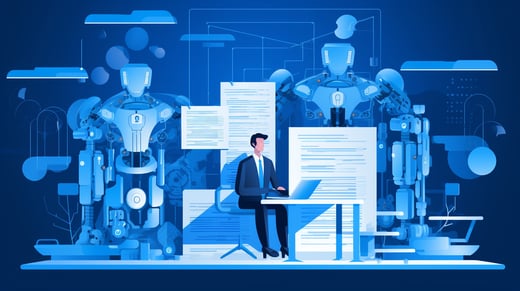As seen in Artificial Lawyer, updated here with addendum - written by Tim Pullan
An insider view on the feasibility and desirability of automated mark-up software.
In the last six years there has been a wave of innovation in legal tech enabled by advances in underlying technologies such as AI. Some innovations beat an inexorable path to productisation and commercial success. Others sound great at first, but in reality represent regression.
Auto-redlining is one such idea. What this phrase describes is artificial intelligence (AI) that scans and automatically redrafts an inbound third party contract to the point where it can be sent back to a counterparty. The idea is to save hours, if not days, of time.
Back in 2019 one of our data scientists called me over to demonstrate one of our experimental models. He typed in 5-6 words, stopped and let the model write the rest of the clause - an IP rights provision. I was amazed. Generative AI technology is an auto-complete capability and because it is really good at mimicking, the output has a human quality. But only at a glance.
I started reading the AI drafting in detail and noted two things. First, it had a tendency to insert instances of gobbledygook amongst otherwise sensible drafting, meaning that output would need to be rigorously checked. Second, it didn’t reflect the position that I would have wanted as an IP owner (it gave away the IP instead of reserving rights) i.e. the AI could not predict intent from looking at a few preceding clauses.
Here in micro were two large technological barriers to developing a product that went beyond interesting gimmick; a product that could be trusted to automatically redline an inbound contract and save a ton of time in doing so. We guessed that both issues might be overcome, but only with a lot of research and large and highly specific and substantial training datasets which would be expensive to compile and benchmark for each client.
Some clients have asked us for a fully automated mark-up capability, as an augmentation of assisted drafting review which we offer today. Assisted drafting speeds up the mark-up process by providing drafting suggestions and making it easy to insert and delete, but leaves the amending decision in each case to the human.
We were and remain skeptical. A scalable capability which can learn how to produce a detailed mark-up of a third party contract without huge configuration will probably become a reality. However, the technical challenge remains significant and there’s the niggling thought that investing in auto-redlining is investing in the past not the future.
Here’s thoughts on why the future might - and should - hold something different.
“If I had asked people what they wanted, they would have said faster horses.”
In this famous - and likely apocryphal - quote, Henry Ford summarized the product developer’s dilemma. What does the customer really want?
Faced with an inbound third party contract, what’s the job to be done by technology? Produce and return a mark-up faster? Or deliver an optimized signed agreement faster?
If you believe these two statements are not in conflict, consider how every insertion and deletion has a price. A price denominated in time for the counterparty to review & consider, seek internal instructions and negotiate. A price potentially paid in additional concessions to agree the change. A price sometimes paid in goodwill. A price sometimes paid in losing the deal altogether. To amend or not to amend - each is a sophisticated and important decision.
In this light, delegating mark-up decisions to a machine makes no sense. If the machine’s job is to mark-up, and has learned this from a large number of historical contracts with a bias towards making and not missing issues, the net result will be a large number of amendments. Even if it’s amazingingly accurate, machine-led mark-up will inevitably increase, not save cost and time.
“A #legaltech request: a software that takes a redline and spits out a sleek issues list for you and the counterparty”
"A #legaltech request: a software that takes a redline and spits out a sleek issues list for you and the counterparty”. These are not our words - the words of a General Counsel on LinkedIn looking to deliver transformation.
To get an optimised agreement to signature with the minimum of effort, the first response is almost always better focused on key issues, as opposed to wording-level concerns, no matter how large or small the deal. Technology’s role - and where innovation can really thrive - is to keep humans out of the word sludge for longer, so that mark-up is restricted to the final phase.
This is why we elected to focus on automatic generation of highly accurate issue lists and assisted drafting capability.
Self writing contracts
So in closing, if auto-redlining is not the future, what is?
There is a future where no-one will mark-up a contract, ever.
Instead of negotiating in the drafting weeds, a combination of technology and practice innovation will enable the entire deal to be summarized, negotiated and agreed at key point level, in language and at a level that all people in the room can understand, and in a structured format that can be analyzed by AI & humans. We can see signs of this emerging already.
If a formal-looking contract document is required, this will be automatically generated as the final non-contentious act of a negotiation. AI will generate the words of the contract based solely on the stated intent of the parties. This is the right way round - humans in control, AI doing the work.
Update
Since writing this article 2 weeks ago (I DID write it all myself) something very significant has happened in AI-land: chatGPT. This has given the wider world a glimpse of how powerful language model technology can be. So it’s fair to ask whether I now have a different view on the desirability of auto-redlining technology. My answer is - no, although it is very good at assisted drafting.
As OpenAI explains, chatGPT has no orientation of truth, it has learned what millions of people have done on different deals with different objectives. So it cannot know what you want to achieve on a deal, and therefore what amendments are necessary, unless that context and intent is provided.
However, I can see potential for experts in particular types of transaction to fine tune a GPT model to mimic how they run a negotiation and thus provide the necessary context and intent orientation. So a user could say ‘Generate a counter party response in the style of John Jones of XYX LLP in a sour mood 10pm on a Friday night’.
Whether that’s a good idea or not…
- Tim Pullan



